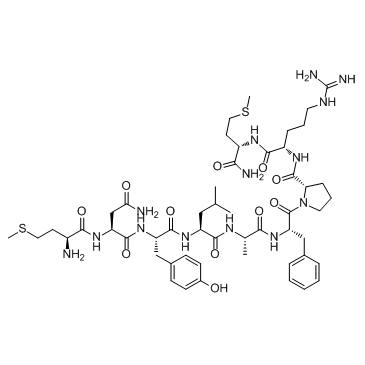Small Cardioactive Peptide B SCPB |
| Catalog No.GC31194 |
Small Cardioactive Peptide B SCPB, a neurally active peptide, stimulates adenylate cyclase activity in particulate fractions of both heart and gill tissues with EC50s of 0.1 and 1.0 μM, respectively.
Products are for research use only. Not for human use. We do not sell to patients.

Cas No.: 84746-43-0
Sample solution is provided at 25 µL, 10mM.
Small Cardioactive Peptide B (SCPB), a neurally active peptide, stimulates adenylate cyclase activity in particulate fractions of both heart and gill tissues with EC50s of 0.1 and 1.0 μM, respectively.
Small cardioactive peptide B (SCPB) is a neurally active peptide endogenous to Aplysia. Small cardioactive peptide B (SCPB) possesses cardioexcitatory effects in Aplysia and reported a threshold concentration of 0.01 nM for both native and synthetic Small cardioactive peptide B (SCPB) stimulated effects on the isolated heart. Effects of Small Cardioactive Peptide B (SCPB) on the physiology of the isolated heart and gill preparations from the mollusc Aplysia californica were examined. In addition, the effects of Small Cardioactive Peptide B (SCPB) and FMRFamide (Phe-Met-Arg-Phe-NH2) on adenylate cyclase activity are compared in particulate fractions of heart and gill tissues, respectively. Small Cardioactive Peptide B (SCPB) is found to exert dose-dependent, reversible changes in cardiac activity when perfused through the isolated heart. The EC50 values effecting changes in heart rate and force of contraction are 0.03 and 0.3 nM, respectively; minimum concentrations find to effect changes in heart rate and force of contraction are normally 0.001 and 1 pM, respectively. When perfused through the isolated gill, Small Cardioactive Peptide B (SCPB) is found to suppress the gill withdrawal response amplitude with a threshold concentration of 0.01 pM and an EC50 value of 0.03 nM. Suppression of the gill withdrawal response amplitude by Small Cardioactive Peptide B (SCPB)is found to be dose dependent and reversible up to a concentration of 1nM. At higher concentrations, the suppression tended to persist irreversibly. Small Cardioactive Peptide B (SCPB) stimulates adenylate cyclase activity in particulate fractions of both heart and gill tissues with an EC50 of 0.1 and 1.0μM, respectively[1].
[1]. Cawthorpe DR, et al. The effects of small cardioactive peptide B on the isolated heart and gill of Aplysia californica. Can J Physiol Pharmacol. 1985 Aug;63(8):918-24.
Average Rating: 5 (Based on Reviews and 18 reference(s) in Google Scholar.)
GLPBIO products are for RESEARCH USE ONLY. Please make sure your review or question is research based.
Required fields are marked with *




















